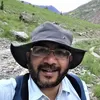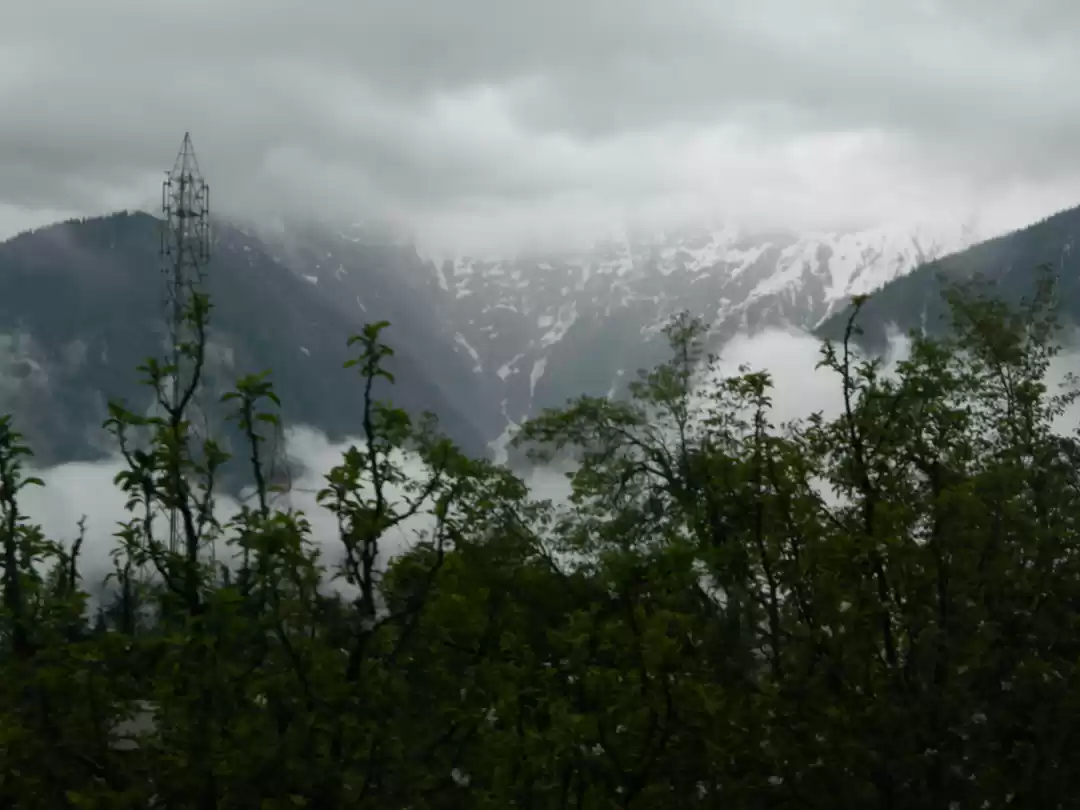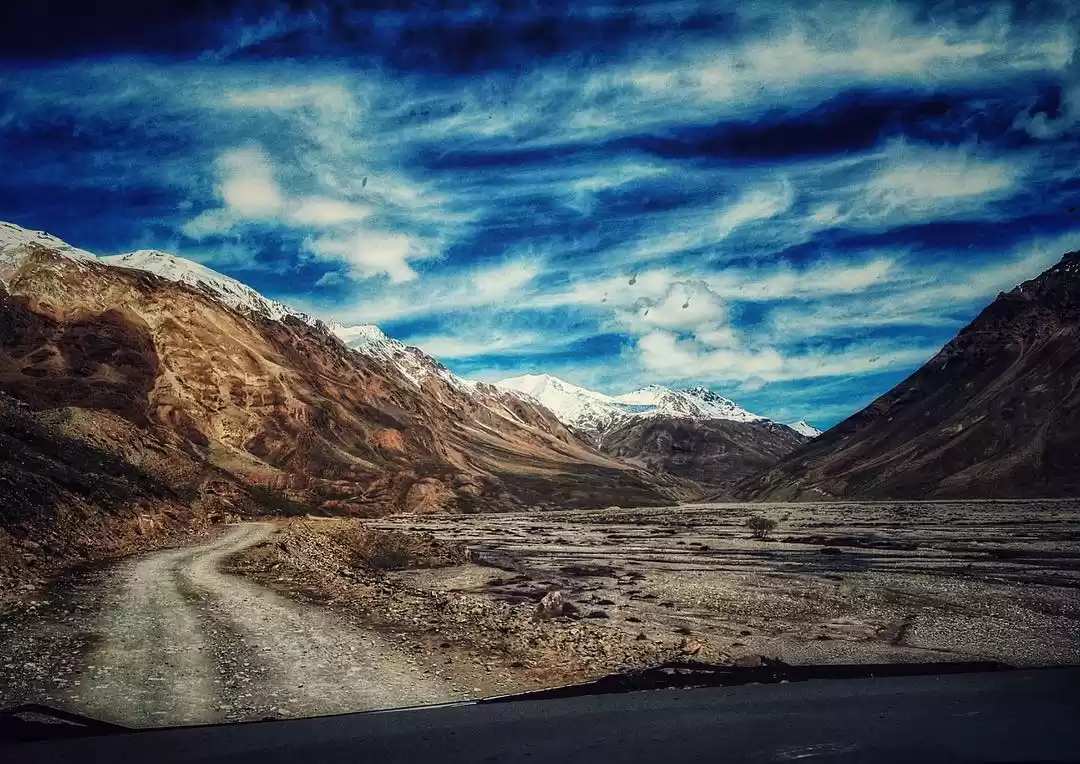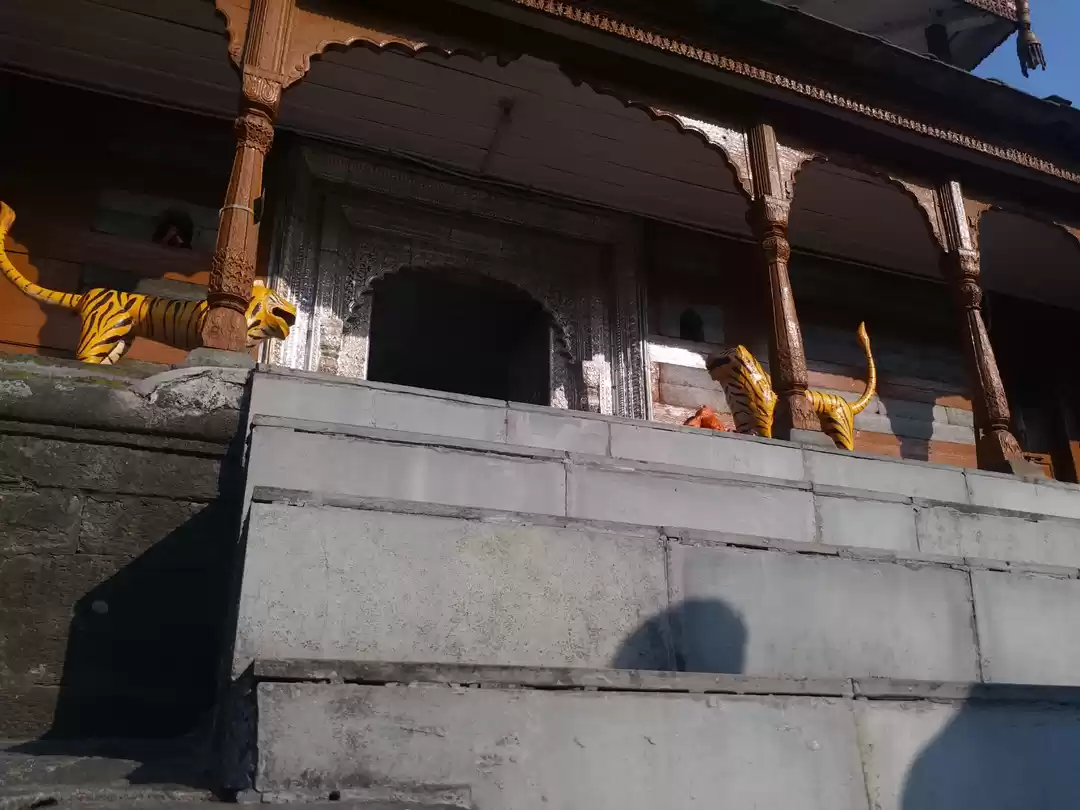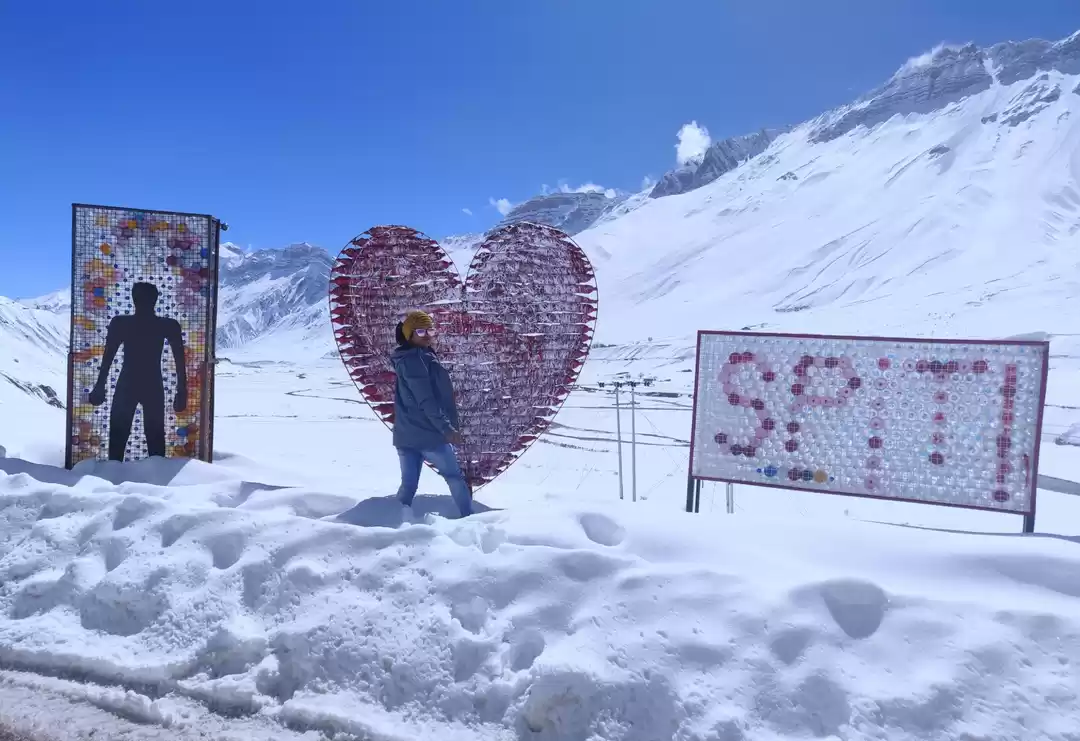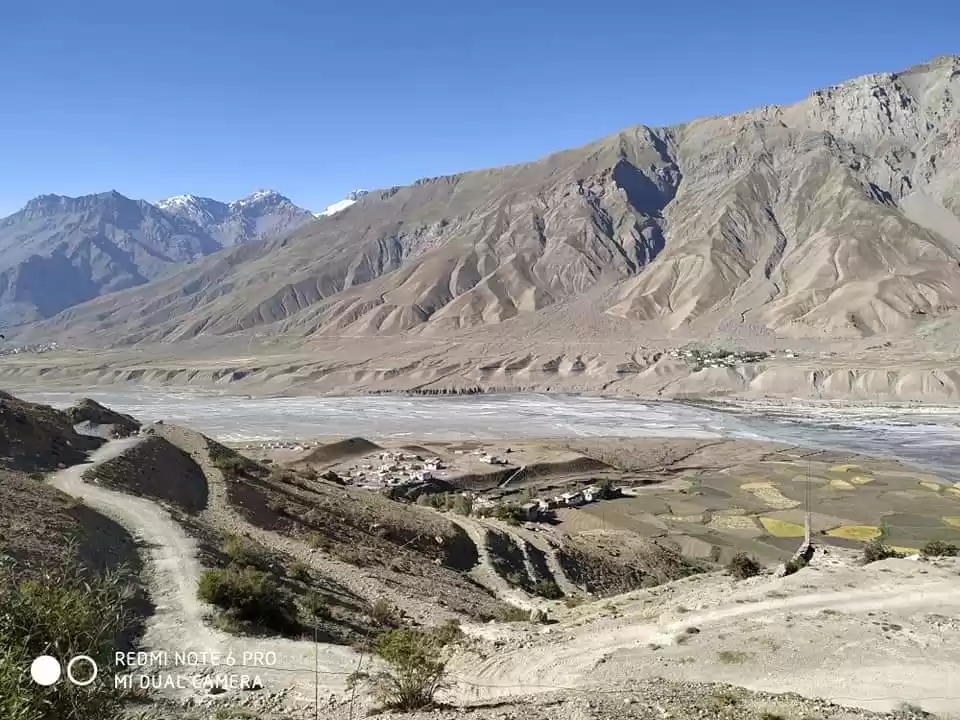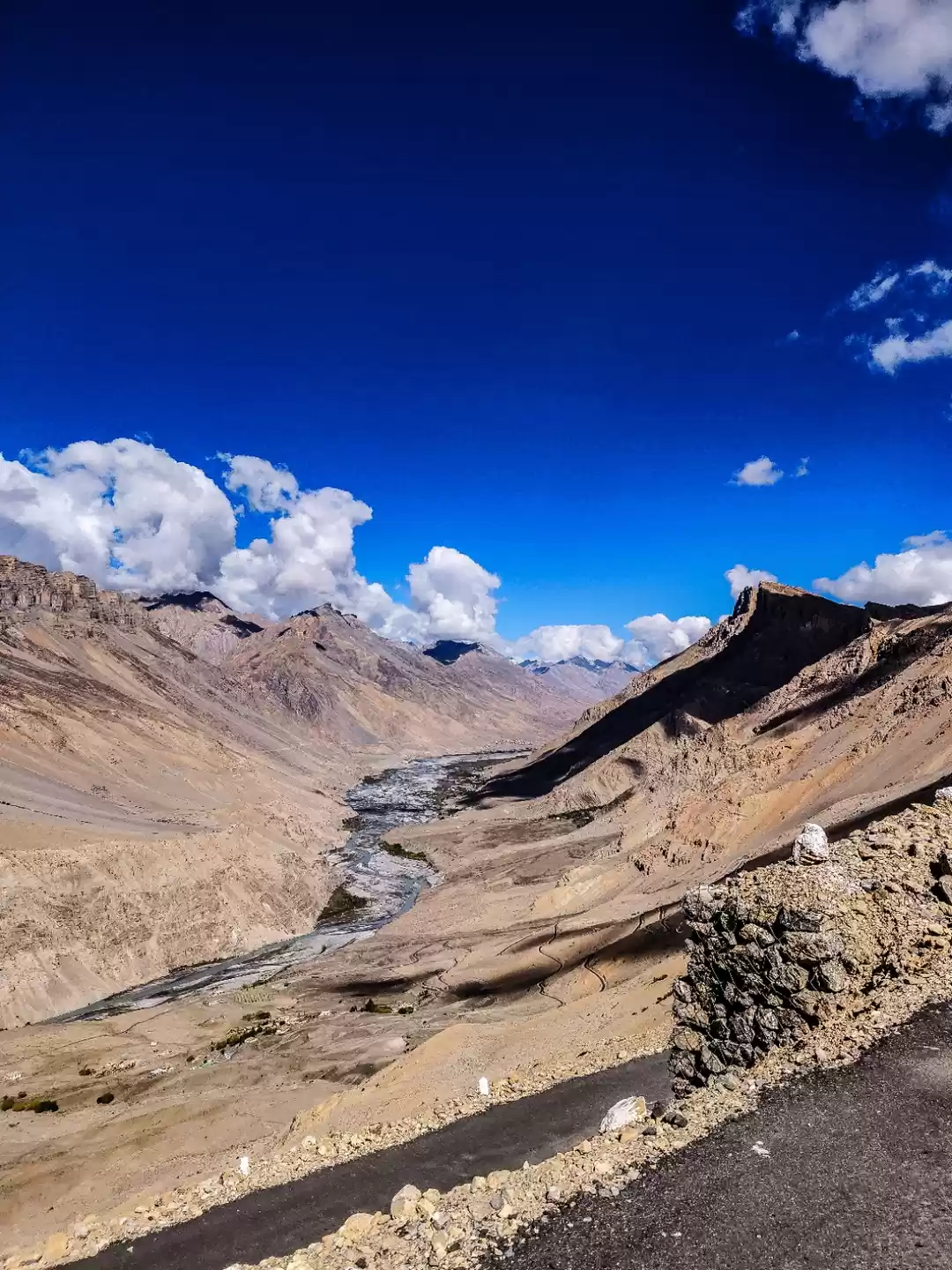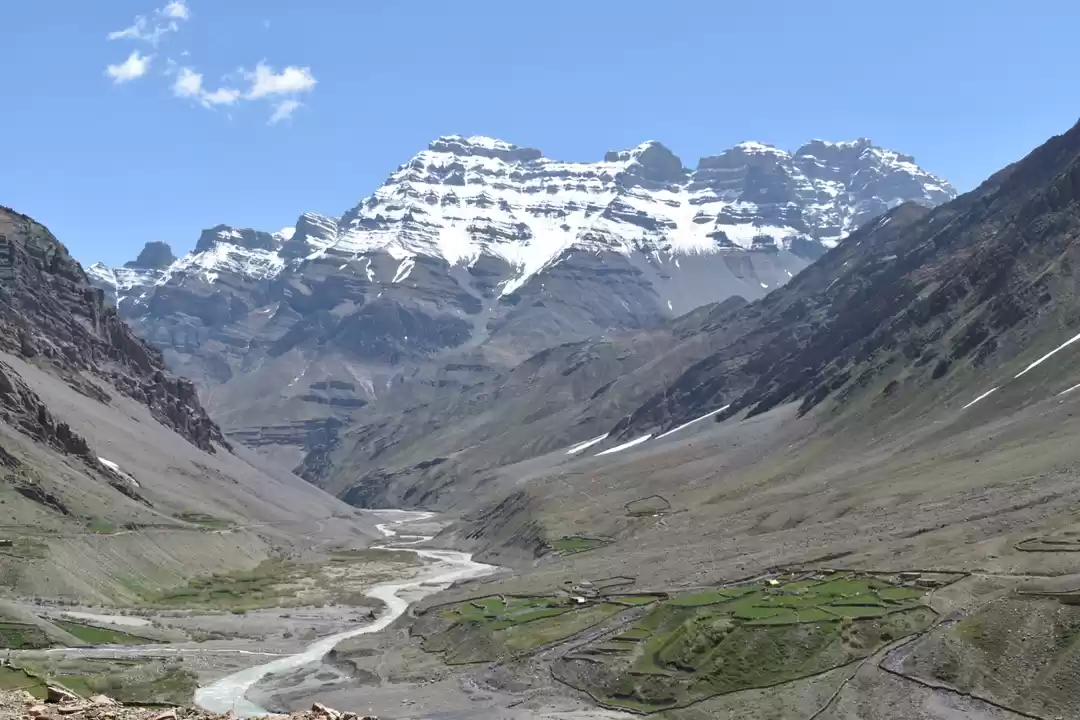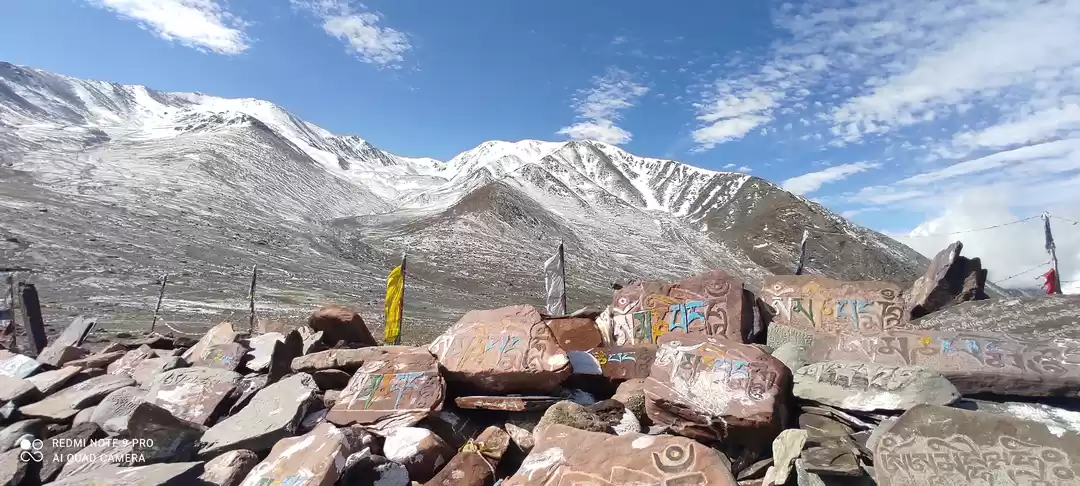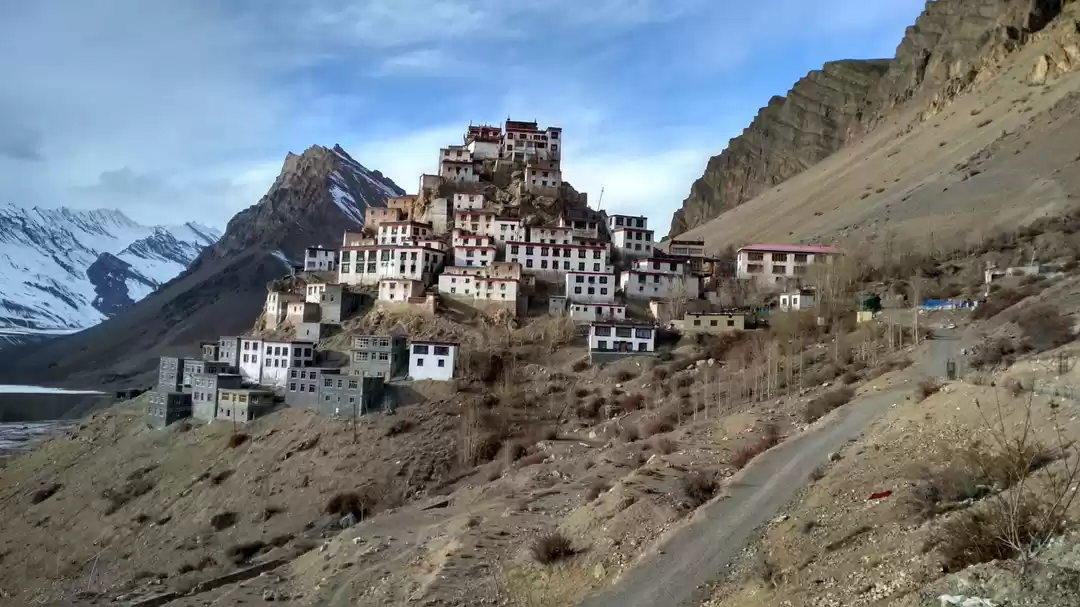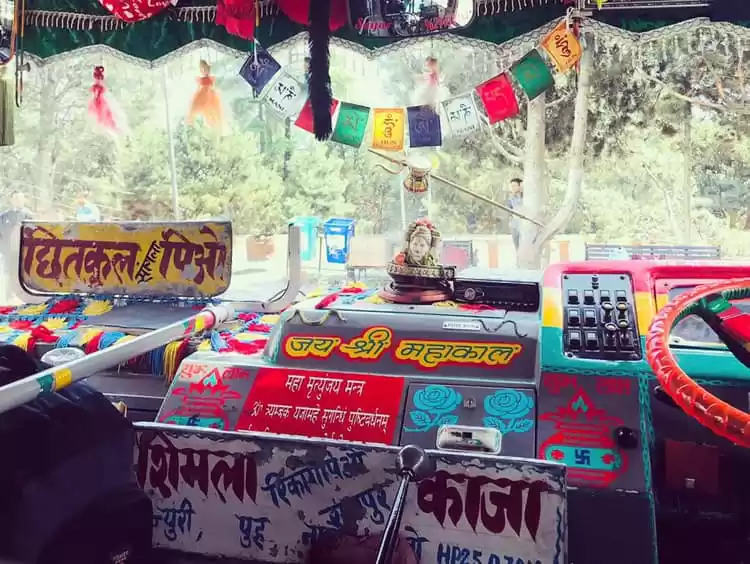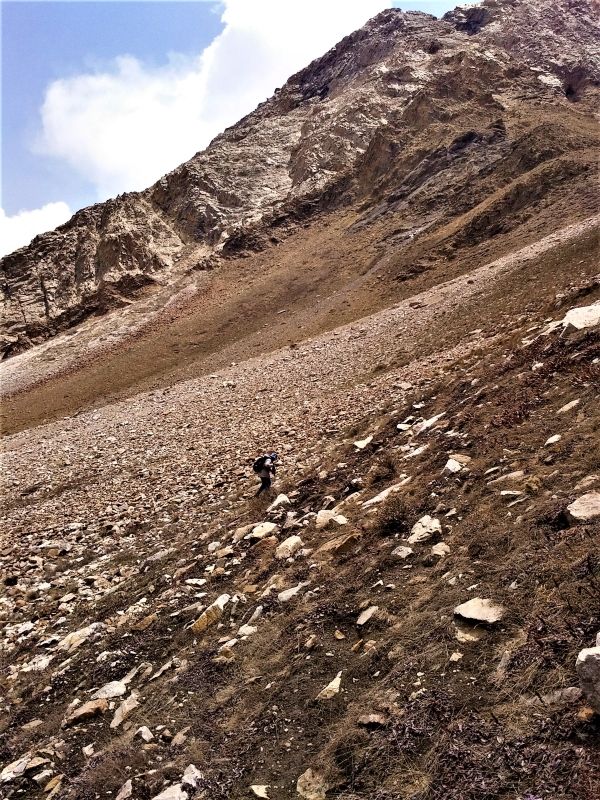
It was warm and humid when we started from Shimla (2276 m) in the morning for Reckong Peo, our halt for the first night. The journey was 225 km long, and if done leisurely as in our case, could take up to 8-10 hours. But that was precisely the point, and we drove comfortably out of the gentle hills around Shimla, past the cherry orchards of Narkanda (from where we purchased boxes of juicy cherries from roadside vends of small farmers), then down towards Rampur-Bushahr and finally, on the scenic NH 5, up and up via Saranhan, Wangtoo, Karcham to Reckong Peo. The NH 5 is a fascinating road that provides you an unending series of spectacular mountain and river scenery and the thrill of high altitude driving. As we climbed up the valley of Satluj in the final part of the day's journey towards Peo (2670 m), the air turned deliciously cool, sign of the chilly weather awaiting us further in Spiti.
The HPTDC hotel Kinner Kailash in Kalpa (2960 m), which is located at a point from where you get very clear views of the eponymous peak and the surrounding range, is a good lodging option in Peo. There are many private hotels both in Peo and Kalpa, which is at a distance of a few kilometres up from Peo. The main market in Peo has some good shopping attractions in Himalayan condiments, dry fruits, cereals and woolens but perhaps you could do your shopping on your way back when Peo would once again provide the most convenient final night halt.






The road to Tabo, in Spiti, is about 150 km from Peo, and again, if you go slowly, savoring the stunning vistas on the way, could take you 7-8 hours. The road becomes precarious on this journey in direct proportion to the breathtaking beauty of the bare mountains and the glistening streams of Spiti. Each village on the way - Pooh (2262 m), Nako (3625), Sumdo (3662 m) - reveals a little bit more of the vast, barren, even harsh yet strangely mesmerizing desolation that is Spiti. The wind in these parts can be cold and biting, lashing the landscape continuously. The dhabas at these stops, though small and ramshackle, provide welcome sanctuaries from the elements, where you can have tea and snacks in case you are not carrying food with you.


We reached Tabo in the evening, by which time the town had settled down for the night. There are again several options for boarding and lodging in Tabo, from small home-stays to medium-sized hotels. The Tabo monastery also has a guest house which you can try out since the main attraction in Tabo is the monastery.
The Tabo monastery, located at an altitude of 3280 m, is considered one of the oldest Himalayan monasteries, in continuous operation since its founding in 996 CE by the famous Tibetan translator Rinchen Zangpo, for the king of Western Tibet. The monastery consists of halls and stupas built of hard, yellow mud of the surrounding cliffs, and wood, the oldest parts of which date back to the 11th century. The last repair of the monastery was done in 1975 after an earthquake. The monastery has a treasure trove of priceless antique and beautiful statues, murals, frescos, scroll paintings or thangkas and manuscripts. You should take your time walking inside the main hall as whatever is on display there is well worth the time spent. Photography is understandably not permitted, and the inside is dim lit, but the holdings of this ancient monastery are truly fascinating. Later, if you are game for some adventure, you might consider climbing up the cliffs near the monastery where the meditation caves of the monks are located.


We started out from Tabo at mid-day, and headed towards Pin Valley. Before leaving, we had a sumptuous lunch at a small home-stay eatery offering an array of Tibetan delicacies including thukpa, tingmo and shabhalay.
Around 32 km and an hour and quarter drive towards Pin is the Dhankar monastery, for which you need to leave the main road and go up on a slant towards a few craggy cliffs on the side of the high, running mountain chain along the road.
At a height of 3894 m, built as a fort to protect it against raiders, it is structurally one of the most endangered major monasteries of the region. Over time, some of Spiti's monasteries had become rich through donations, thrift and hoarding, and often became victims of mobile politico-military formations that struck out of the Punjab and Kashmir zones in search of riches. Dhankar was until recently the headquarter of the Spiti sub-division of the Lahaul and Spiti district.
As we walked up the path leading to it, the monastery appeared to rise from behind the ledges on which it is located, creating a pretty picture alongside a cluster of tall, ant-hill shaped mud spires in the final stretch of the path to it.







Pin Valley or officially the Pin Valley National Park, is a long, broad and flat valley where the Pin river flows slowly along a gentle gradient in the form of a continuously splintering and re-joining set of streams over a wide, sandy bed. The river is flanked by an endless chain of interlocked mountains on both sides, wide apart, every part of the chain being more breath-taking than the other. Though the road is gravelly, and often broken and difficult to negotiate, when you look out, you feel like you are flipping through the pages of the sketchbook of a master artist.

The Pin river valley just drew us in and we drove on and on, unable to stop, savoring the endless sights all around. But then it began to grow dark and cold, and the condition of the road worsened so that we were forced to look for lodging. We explored possibilities of night stay at several small villages on the way but eventually settled for Mud (pronounced 'moodh'), the last village on the road. Mud is a tiny village on the banks of Pin river, where the valley opens up considerably, making it look like we had zoomed in on the scenery. There are a few basic home-stays and restaurants here as Mud is the base camp for the Pin Parvati trek. We decided to stay at Ibex Home-stay, and were relieved to get indoors as the wind was by now biting cold.

After a heavy breakfast, and packing some snacks for lunch, we headed across the Pin river to walk on the mountain slopes on the other side. Once we had crossed the river over a small bridge and found ourselves at the bottom of the mountain slope, we could either choose to walk along the lower ledge bordering the river, past yaks grazing on the hard grass matting the ground, or climb the scree covered glacial ribs of the mountain that lay vertically on the slope. Either way, the rugged land revealed both its beauty and harshness, and we were both intimidated by it yet drawn into its arms.








The Pin and Kibber (will be discussed a little later) valleys are sanctuaries for several Himalayan animal species like the Ibex, the Snow leopard and Himalayan fox. We saw domesticated yaks grazing in the mountain slopes around Mud, and if we were not mistaken, also a shy fox near a small stream by the village the night before.
After almost half a day spent trekking, and thoroughly satisfied, we returned to Mud. We spent the evening relaxing, with a drink of the divine chhaang, a local beer made by fermenting millet and barley.
Kaza is the largest settlement in Spiti, and its sub-divisional headquarter. It has the buzz of a backpacker's haven, with chic cafes and music bars. New Kaza has a couple of wide poplar-lined streets along which government offices and the larger hotels are located. Old Kaza is a little congested and has the main market and cafes. We decided to stay at the HPTDC hotel 'The Spiti', in new Kaza. It is located on the east (high) bank of the Spiti river, is close to Spiti's only gas station and the main monastery, and has a good view of the valley from the back of the hotel. Hotel Deyzor is also a good option, and definitely recommended for food. The shops in the main market can yield high quality woolens, local dry fruit and herbal products, and Spiti souvenirs.




In the two years (2016-18) that I was a Fellow at the Indian Institute of Advanced Study, Shimla, Spiti was this mysterious, awe-inspiring land everyone talked about, but it was too far for any trip we could manage in the weekends we got off from work. So as my time in Shimla drew to a close, I was determined to travel to Spiti, even if it meant going away for 7 to 10 days, the minimum time one would need to do a meaningful trip to this far corner of Himachal. So towards the end of May 2018, my friends and I took off for Spiti. There were 6 of us so we hired 2 sedans from our trusted local travel expert Lali ji (mentioned in an earlier blog on Lahaul), and he and another driver from his circle were to drive us to Spiti and back.


One of India's remotest regions, Spiti, meaning 'Middle Land' in Bhoti (a Tibetan Group language), lies embedded in the high mountains of the Himalayas in the north-eastern part of the state of Himachal, and is one of the bridge/connecting regions between Tibet and the Indian subcontinent.


Shielded from the monsoon winds of the sub-continent, the Spiti Valley is actually a desert, with barren mountains and very sparse scrub vegetation. But after Sumdo, when you enter the Spiti Valley, the Spiti river, a tributary of the Satluj, provides the central geographic phenomenon around which this land is cast. Flowing shallow and slothfully over a large bed, the Spiti river is the lifeline of this land.


Historically, the inaccessible valley of Spiti has been home only to isolated monasteries and small client communities that lived by petty cultivation and animal husbandry, the lamas seeking spiritual goals best pursued by detachment, and the communities seeking escape from centralizing socio-political formations of the plains. Trade links between Ladakh, Kullu and Tibet ran through this region, and ensured communication between peoples and supplies of commodities.


We woke up to a glorious, sunny day. Because the temperature was still quite low, some sunlight and warmth was absolutely essential if we wanted to trek a little that day. Which is indeed what we wanted to do, given how enchanting and inviting the landscape was.

Small and scattered villages like Mud comprise the settlement geography of Spiti. Facing extreme cold conditions for most of the year, the people of Spiti live on the meagre cultivation of barley, wheat, black peas and related grains and pulses, and the animal products obtained from tending yaks and dzos (hybrid of yak and plains cattle). In recent years, green peas that are in great demand in the plains have seen a massive expansion in cultivated acreage in Spiti.


Though Pin was difficult to leave, and there were so many more treks one could have done, we started for Kaza the next day in the morning as we had only a week to wrap up Spiti. For this jorney, we had to return to the main Tabo-Dhankar road and then continue further for another 5o km up to Kaza, which lies at an altitude of 3800 m.



We spent the evening soaking in the sights and sounds of Kaza. It comes alive in the evening, as brightly lit cafes and hotels lay out delectable food and drink, and play foot-tapping music which provides both a pleasant atmosphere for conversation as well as sufficient incentive to shake a leg. The cool night keeps everyone invigorated lest the heady sense of being so far out and away from everything get the better of you!
The day was bright and coolish for an exploration of the higher parts of the Spiti Valley beyond Kaza. We started off for Key monastery after a sumptuous breakfast at Deyzor. Perhaps an offshoot of the 11th century Kadampa monastery in Rangrik village (across the river from Kaza at a short distance, which we regretted not visiting), Key is the largest monastery in Spiti. Tibetan Buddhism is the dominant religion in Spiti, and the three big monasteries of Key, Dhankar and Tabo are under its youngest sect, the Gelugpa. The monastery has faced many invasions and calamities in the past but continues to go strong.




We had arrived in good time to see the main prayer for the day, when all the lamas assemble in the hall, and sit row after row, solemnly chanting their mantras. This was also a special day on which a devotee had given a large sum of money as gift to the monastery on the occasion of a marriage in his family. As currency notes from the gift were being distributed to the lamas in a token ceremony by the benefactor, while the older lamas maintained a serious demeanor, the children among them started playing with the notes in amusement. It was quite a sight to see them unmindfully dissolving the somber atmosphere of the prayer into a light situation of play and mirth. I later found out that parts of such gifts are often divided among the lamas and this is their pocket money for a little personal indulgence when they go to the market in Kaza once a month.
After spending some time at Key, we headed higher towards Kibber (4270 m) and Kormic (4587 m). Kibber, a major station in the trade route to Tibet, also has fertile cultivable land, and as a Wildlife Sanctuary, a large number of snow leopards and rare herbal/medicinal plant species. We could not go all the way up to Kormic as our cars were having difficulty breathing at this extraordinary altitude.




But the high point of this trip was the absolutely stunning topography with a welter of intertwined mountains and valleys in different shades of blue, brown and purple that made the land look like a moonscape; and the mysteriously refreshing air that gently blew over it.



We returned to Kaza for a last night in Spiti before starting for Shimla. The next two days would be spent traveling back, with a halt in the middle at Peo. But we were leaving Spiti completely mesmerized. Though it was clear that life in these parts was deprived of all the comforts we take for granted back home, Spiti had come to have a strangely bewitching hold on us. I think that it is the remoteness and isolation of this land of other-worldly beauty that makes it so compelling for us, who have perhaps had enough, at one level, of our cramped and busy lives in the mainland.
However, Spiti is neither completely cut off today, nor madly joining the race to catch-up. Two images bear this balance out. On the one hand they are now cultivating the lucrative cash crop Sea Buckthorn (of our exotic juices and chocolates) in Spiti, on the other, it is still a land that has preserved a 500-year old mummy of a monk in Giu, 7 km off the main road after Sumdo on our way back.


The journey back was like a replay of our wonderful, scenic travel into Spiti Valley, but in reverse. Here are some pictures of the scenery on our way back. Until we meet again!









Bye!

